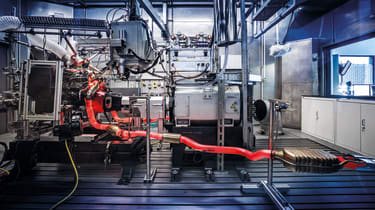Mercedes-AMG GT – tuning the perfect exhaust note
Turbocharging heralded the end of the traditional AMG exhaust bellow. Yet that wasn’t at all the case…
‘The throttle response and rate of acceleration away from the corner is astonishing… and the exhaust sounds appropriately dirty in its noisy mode.’
You’d be mistaken for assuming this line was taken from a review of AMG’s old 6.2-litre, naturally-aspirated V8. No matter which car the engine was installed in, those eight cylinders consistently provided a thunderous soundtrack of a kind more often found circulating oval circuits in America.
But no, those words are from road test editor Dan Prosser, directly from our group test of the Mercedes-AMG GT S from evo 210. The new 4.0-litre sports car sounds fantastic when fully lit, despite the muffling effects of its twin, ‘hot V’-mounted turbochargers.
Traditionally, turbocharging has meant healthy reserves of power but a muted soundtrack. When a bellowing exhaust note is so inexorably linked with so many respected AMG performance cars, absence of it is at best a disappointment, at worst detrimental to the driving experience.
We need not have worried. As the introduction demonstrates, AMG has retained the aural character of its previous models – and it’s all down to careful exhaust tuning.
‘Excitement, emotive appeal and recognition value’ are three characteristics Mercedes-AMG focused on during development of an exhaust system for the GT. The answer was fully variably controlled exhaust flaps, activated by the driver with a switch in the cabin.
Specifically, AMG fits an exhaust flap on either side of the rear silencer, variously activated by engine speed, the selected transmission mode and throttle opening. Potter around at low revs and low load and the flaps stay closed. Exhaust gases take a longer path through an additional sound damping element, minimising sound and resonating frequencies.
The harder you accelerate, the further the flaps open, gradually introducing the typical AMG V8 sound – until at full throttle, both flaps open fully for maximum impact.
Of course, the driver can opt to activate the exhaust flaps fully from the off, using a button on the centre console. The car burbles more at idle, growls under acceleration and roars at full throttle.
The sound still isn’t quite comparable with the old naturally-aspirated V8 – they are, after all, different designs. Like musical instruments, the construction of the engine, its exhaust ports and the shape of the exhaust system itself all influence the sound, and the GT’s twin turbochargers and their effect on exhaust gases still influence its aural characteristics.
But like other AMG engines, the new 4.0-litre has plenty else to recommend it – from the unique ‘one man, one engine’ build process, to the 503bhp and 479lb ft outputs of the GT S and its hair-trigger throttle response. That engine and exhausts are also attached to a chassis as talented and body as striking to behold as those of the GT is cause for celebration.
If you've not already seen (and heard) it, you can see our take on the AMG GT S in the video below:








